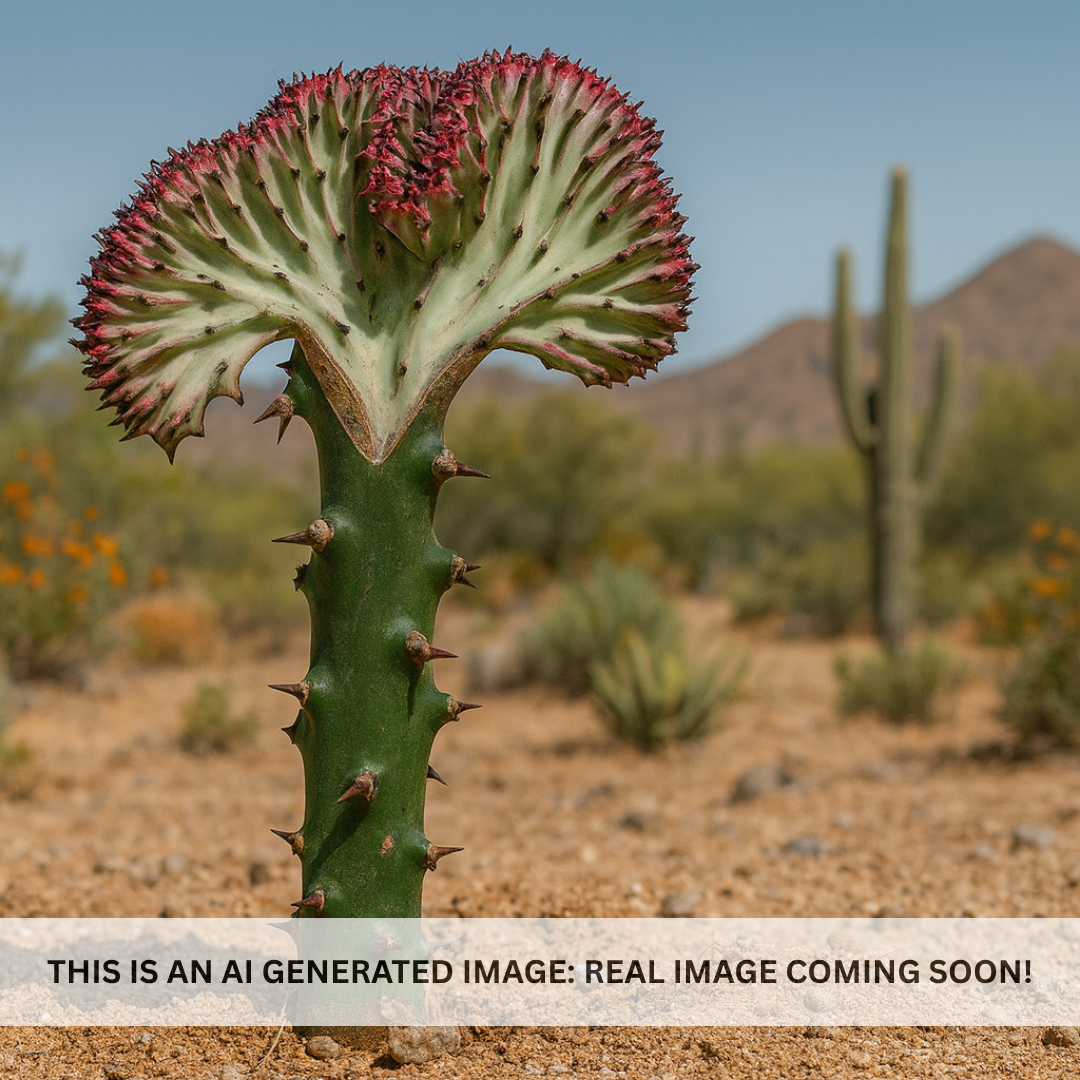My Store
Crested Lucky Cactus
Crested Lucky Cactus
Couldn't load pickup availability
Plant Type: perennial, succulent
Plant Height: 12–36 inches (occasionally larger in maturity)
Spread: 12–24 inches
Flower Color: yellow-green
Sun Exposure: Full sun, Partial Shade
Crested Lucky Cactus / Euphorbia ingens Crested: A Rare, Sculptural Form of the Candelabra Tree
Euphorbia ingens Crested, commonly called the Crested Lucky Cactus, is an extraordinary mutation of the standard Euphorbia ingens—the famous African Candelabra Tree. This rare, fan-shaped variety forms undulating, coral-like crests rather than upright columnar stems, creating a dramatic, sculptural centerpiece that looks almost otherworldly. Its intricate form and bold silhouette make it a collector’s favorite and a stunning statement piece for modern desert gardens or high-design landscapes in Arizona.
Key Features of Euphorbia ingens Crested
The Crested Lucky Cactus grows in mesmerizing, fan-shaped waves of thick, deeply ridged tissue. Each crest displays intricate folds and curves along its ridges, giving it an appearance somewhere between coral and ruffled lettuce. The surface color varies from bright green to deep emerald, often with bronze or purple undertones when grown in full Arizona sun. Small yellow-green cyathia (flowers) occasionally appear along the ridges in late fall or winter, though its sculptural form is the main attraction. This variety produces the same milky latex sap as other euphorbias, so gloves and eye protection are recommended when handling or transplanting.
Growing and Care Tips
Crested Euphorbia ingens thrives in bright light, preferring full sun to partial shade. In the Phoenix Valley, the ideal location provides full morning sun and partial protection from harsh afternoon exposure, especially during its first year. It requires sharply draining soil—standing water can quickly cause stem rot. Once established, it is exceptionally drought-tolerant and thrives with minimal irrigation. Frost-sensitive, it should be covered or brought indoors during cold spells below 35°F. The crested form grows slowly compared to standard Euphorbia ingens, making it perfect for containers or focal points where detailed structure can be admired up close.
Landscaping Uses
The Crested Lucky Cactus is the epitome of living sculpture. It’s ideal for use in containers, rock gardens, or as a centerpiece in minimalist or modern landscapes. Its unique form pairs beautifully with simple companions like Golden Barrel Cactus, Blue Glow Agave, or Silver Torch Cactus—plants that allow its complex shape to stand out. When used in high-end desert landscapes, its coral-like crown introduces visual movement, texture, and elegance. In large planters or raised beds, it becomes a living work of art that looks stunning against stucco walls, dark stone, or metal backdrops.
Summary
Euphorbia ingens Crested is a rare and mesmerizing succulent that transforms any landscape into a gallery of natural design. Its dramatic crested form, durability, and architectural symmetry make it both a conversation piece and a symbol of luck and prosperity. With its low water needs and sculptural grace, the Crested Lucky Cactus is an exceptional choice for Arizona landscapes that celebrate beauty in form and restraint.
Three Timbers Installation Guide (Feel Free to Follow):
Euphorbia ingens Crested Planting Guide:
Location: Full sun to partial shade; provide bright morning light and some afternoon protection during Arizona’s summer heat for optimal color and shape retention.
Soil: Use a sharply draining cactus or succulent mix blended with gravel or pumice. Avoid dense or clay soils that retain moisture.
Spacing: Allow 18–24 inches of space from other plants or hardscape elements to highlight its unique form and ensure airflow.
Planting Depth: Keep the crown level with the soil surface to prevent moisture accumulation at the base.
Support: Not required; the crested structure is self-supporting and grows slowly into a stable fan shape.
Watering Guide:
Watering After Planting: Water deeply after installation to settle the soil. Then allow the soil to dry completely before watering again. During establishment (first 2–3 months), water every 14–20 days depending on temperature and sun exposure.
When is the Plant Established? Euphorbia ingens Crested is considered established after 6–8 months, when the fan shape expands consistently and the base thickens.
Watering Once Established: Once rooted, water sparingly—typically once every 4–6 weeks during summer and rarely in winter. The plant prefers dry conditions.
Drip Irrigation Setup: Install one low-flow emitter (0.5–1 gallon per hour) about 8–10 inches from the base. Run infrequently and allow complete soil drying between cycles.
General Watering Tips: Always confirm soil dryness before watering. Overwatering can lead to crown or root rot. Apply decorative gravel or rock mulch to conserve light surface moisture and accentuate the plant’s structure, keeping it several inches from the base for airflow and longevity.
Share












